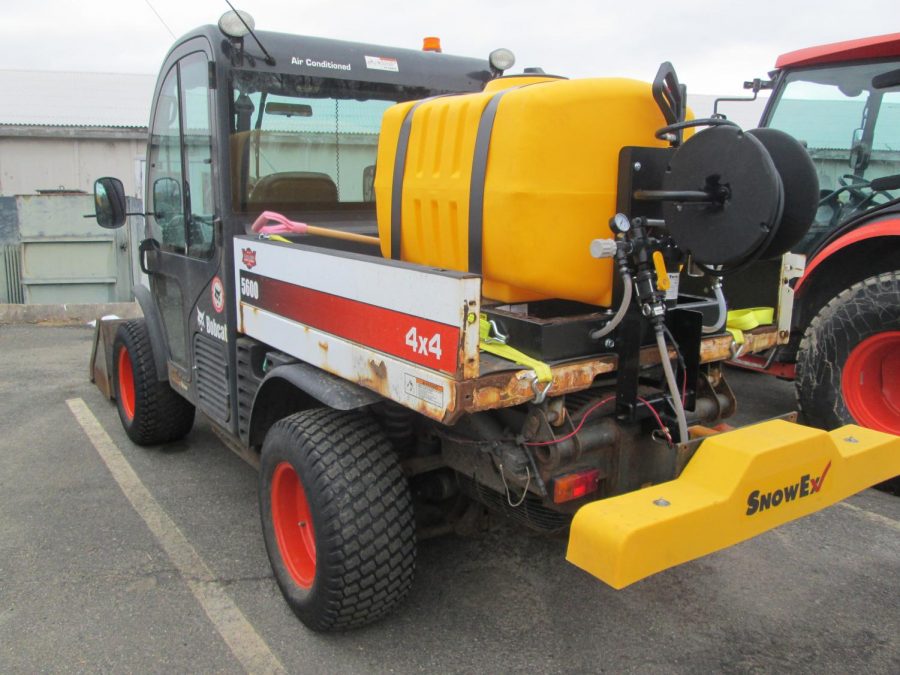Braving another winter in New England, the University of Massachusetts has adopted a new tool to combat winter weather events before they happen: salt brine.
According to UMass News and Media Relations, a pilot program has begun to treat roads and sidewalks on the campus with an anti-icing solution of rock salt and water known as salt brine. Salt brine is sprayed in advance of a winter weather event using a tank which has been installed on the back of road- and sidewalk- sanders. The treatment was first used in mid-January and will continue to be employed throughout the winter.
“This is a 24-hour-a-day campus,” Todd Cournoyer, the head of landscape management, said. “Snow, ice, winter weather can’t slow the campus down.”
Cournoyer and other staff, including Custodial and Grouds Services assistant director Pam Monn, became interested in liquid anti-icing treatments after attending a presentation by Baystate Roads, a program at the UMass Transportation Center. Michael Smith, a UMTC program director, advised the Physical Plant on the adoption of salt brine and held multiple training workshops with staff.
On Tuesday morning, Cournoyer walked around the Grounds Maintenance Facility on the outskirts of campus and explained the challenges faced by the over 200 snow removal workers at the University, including custodial staff.
While the sidewalks and roads are typically warmer than the air, snow and ice accumulation lower ground temperature. The precipitation can then bond to the surfaces and cause slippery and dangerous conditions.
Traditionally, the University relies on the granular application of salt, treated with organic compounds like beet or sugar root, to prevent snow from bonding with the ground surfaces and assist in melting snow left behind after plowing. While salt can be corrosive, Smith said organic-based enhancers can make solutions “less corrosive than drinking water,” citing a study done by the Pacific Northwest Snowfighters.
A major disadvantage of rock salt is that won’t activate until wet, Smith and Cournoyer emphasized.
Smith, who specializes in snow and ice education, as well as gravel road maintenance, chainsaw safety, trench excavation safety and similar topics, added that “rock salt doesn’t do anything for us until it becomes a liquid.”
“The grain of salt leeches the brine, which lowers the freezing temperature of water,” Cournoyer said. However, the salt is often inefficient, as it is kicked around by pedestrians and vehicles. “That salt crystal, with all its surface area, is only in contact with the pavement on one small area.”
Cracks and crevices in roads and sidewalks pose another problem. When a plow passes over the area, some snow and ice material can be further ground into these crevices. Over time, this build-up will be more resistant to removal and pose dangers to pedestrians and drivers.
Salt application prompts environmental concerns as well. While sodium chloride is a “natural element,” the high concentration used to combat winter weather can be damaging to plant life, waterways and other parts of the environment. In the past, UMass has utilized salt brines including liquid calcium chloride and magnesium chloride, which were very effective in melting the ice but posed dangers to the environment.
“Those particular chemicals, calcium and magnesium, were just a little more harmful to the environment than we were willing to accept,” said Cournoyer, who has worked at UMass for more than 25 years, including six or seven years in his current position.
The new aqueous brine solution used by the University is 23 percent salt and 77 percent water. Since the salt is completely suspended, the mixture looks like regular water. Cournoyer noted that the salt brine solution acts “instantaneously.”
When applied to roads and sidewalks, a very fine layer of salt is left behind. With a pencil nozzle for high-speed application, thin lines may be left behind on the treated surface. UMass also uses a fan nozzle, which leaves no lines behind.
“Salt brine is more efficient,” Smith explained in a phone interview with the Daily Collegian, adding that it uses less salt and is less labor intensive.
“Salt brine will last indefinitely as long as it’s not exposed to rain or other precipitation,” Smith added. Unlike rock salt, salt brine doesn’t blow off the roads and only needs to be reapplied once plowing starts.
Environmentally, salt brine can cut the application rate of salt “in half,” Smith said. The application rate of an anti-icing agent can range from 30 to 60 gallons per mile, Smith said. In 60 gallons of salt brine, there are only 136 pounds of salt, which is half the amount of salt used compared to a rock salt application.
The department will continue to use granular application for the foreseeable future as treatment in the aftermath of weather events. However, with less snow and ice bonding to road surfaces initially, less granular salt is needed during cleanup. When asked about future developments in the use of salt brine, Cournoyer said the department is hoping to use less sodium and develop a more controlled application.
“Every time we hear somebody fell and got hurt, we feel really badly,” Cournoyer said. “Our main concern is safety to the students.”
Kathrine Esten can be reached at [email protected] and followed on Twitter at @KathrineEsten.




















